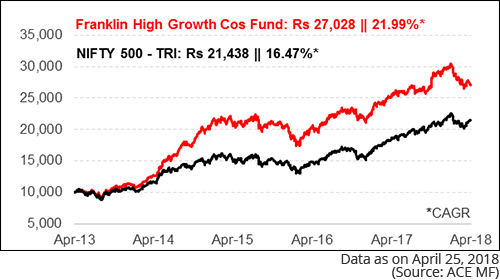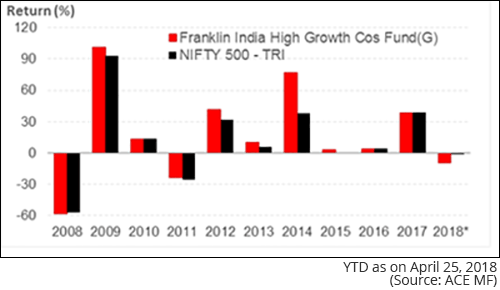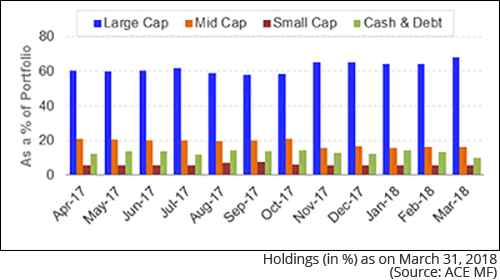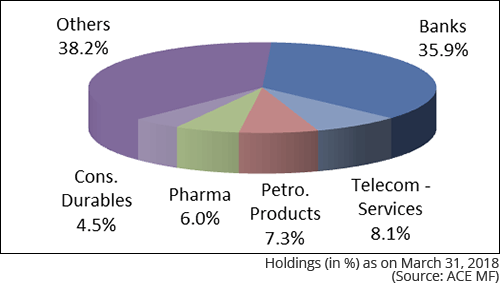- Home
- Outlook Arena
- Outside View
- Outside View (PersonalFN)
- Franklin High Growth Companies Fund Renamed Franklin Focused Equity: A Change In Strategy?
Franklin High Growth Companies Fund Renamed Franklin Focused Equity: A Change In Strategy?May 4, 2018

On April 19, 2018, Franklin Templeton Mutual Fund announced its proposal to change certain features of its schemes as a part of the categorization and rationalization guidelines issued by the market regulator. In line with this, Franklin India High Growth Companies Fund will be classified as a Focused Fund, with effect from June 4, 2018. The scheme will then be renamed to Franklin India Focused Equity Fund.
What has changed? Nothing critical really, Franklin India High Growth Companies Fund will continue to remain a multi-cap oriented fund focused on companies and sectors with high growth rates or potential.
While Franklin India High Growth Companies Fund did not have a restriction on the number of stocks, it maintained a focused portfolio of 30-35 stocks in the past five years. Hence, the fund house rightly classified the scheme as a Focused Equity fund investing in maximum 30 stocks.
So in short, the classification has only brought about a change in name. The multicap fund may get some more flexibility in terms of asset allocation. As per the new mandate, the minimum exposure to equity has dropped to 65% from 70% earlier. However, over the past five years, the exposure to equity has rarely fallen below 85%.
In terms of performance, Franklin India High Growth Companies Fund has been a decent long-term performer. It has outperformed the benchmark by a decent margin over the 3-year and 5-year periods. Unfortunately, the multi-cap scheme has disappointed in the past two years. The returns have fallen short of the benchmark and the top peers in the category.
The concentrated strategy does create additional volatility, but investors are well compensated in the form of returns if the stocks perform in favour of the fund manager.
In this brief analysis, we take a close look at the features and performance of Franklin High Growth Companies Fund.
Franklin India High Growth Companies Fund has an investment objective to "achieve capital appreciation through investments in Indian companies/sectors with high growth rates or potential." Under the new scheme classification, the investment objective of the fund remains the same.
| --- Advertisement --- [BUSTED] The 'Hot Stock' Myth… For the past 16 years, the Bombay Investing Society has stood against getting rich with the 'Next Hot Stock'… And while maintaining its stand, has successfully guided over 7,000 of its members towards double, even triple digit returns! Don't believe us? Click here to know more… ------------------------------ |
Franklin India High Growth Cos Fund Details
Fund Facts
| Category | Diversified | Style | Focused |
|---|---|---|---|
| Type | Open ended | Market Cap Bias | Multi-cap |
| Launch Date | 26-Jul-07 | SI Return (CAGR) | 13.15% |
| Corpus (Cr) | Rs 7,415 | Min./Add. Inv. | Rs 5,000 / Rs 1,000 |
| Expense Ratio (Dir/Reg) | 1.30% / 2.44% | Exit Load | 1% |
SI Return as on April 25, 2018.
(Source: ACE MF)
Under normal circumstances, Franklin India High Growth Cos Fund (Franklin India Focused Equity Fund) will allocate...
- -5% - 100% to equity and equity related securities
- 0%-35% to debt and money market instruments
Do note, this asset allocation will be effective July 4, 2018. Till then the existing allocation defines a minimum 70% exposure to equity and a maximum of 30% to debt instruments.
Growth Of Rs 10,000, If Invested In Franklin India High Growth Cos Fund 5 Years Ago

Had you invested Rs 10,000 in Franklin India High Growth Companies Fund, five years back on April 25, 2013, it would have grown to Rs 27,028 as on April 25, 2018. This translates in to a compounded annualised growth rate of 21.99%. In comparison, a simultaneous investment of Rs 10,000 in its current benchmark - Nifty 500 - TRI would now be worth Rs 21,438 (a CAGR of 16.47%). Over the past five years, Franklin India High Growth Companies Fund has taken a lead over the benchmark when the market rallied post-May 2014. Through the years, it has managed to maintain the gap over the benchmark, leading to a decent alpha at the end of the 5-year period.
Franklin India High Growth Cos Fund: Year-on-Year Performance

Franklin India High Growth Cos Fund has a track record of over a decade. The year-on-year performance of the fund vis-a-vis its current benchmark - Nifty 500 - TRI has been quite decent. In most periods, it has outperformed the benchmark by a decent margin. In some years, the returns have fallen marginally short of the benchmark. It has not disappointed when the market has rallied, delivering a significant alpha over the benchmark. Bulk of its outperformance in the past few years has come in the market rally of 2014-15, as it outscored the benchmark by nearly 39 percentage points. In the past 2-3 years, the performance has been subdued. This may have disappointed some investors.
Franklin India High Growth Cos Fund: Performance Vis-à-vis Category Peers
Rolling Period Returns
| Scheme Name | Corpus (Rs Cr) | 1 Year | 2 Year | 3 Year | 5 Year | Std Dev | Sharpe |
|---|---|---|---|---|---|---|---|
| SBI Magnum Multicap Fund | 4,704 | 23.19 | 18.83 | 17.39 | 21.44 | 13.48 | 0.13 |
| DSPBR Equity Opportunities Fund | 5,069 | 25.06 | 21.22 | 17.25 | 21.02 | 14.78 | 0.13 |
| Aditya Birla SL Equity Fund | 8,503 | 24.16 | 21.42 | 16.59 | 22.52 | 14.03 | 0.13 |
| Principal Multi Cap Growth Fund | 629 | 32.10 | 22.96 | 16.39 | 21.89 | 16.63 | 0.14 |
| Mirae Asset India Equity Fund | 6,775 | 26.05 | 19.78 | 15.84 | 21.41 | 13.86 | 0.11 |
| Franklin India High Growth Cos Fund | 7,415 | 21.92 | 15.97 | 15.22 | 23.87 | 14.88 | 0.04 |
| JM Multi Strategy Fund | 139 | 28.19 | 20.72 | 15.22 | 19.74 | 15.58 | 0.09 |
| Sundaram Equity Multiplier | 337 | 25.86 | 18.24 | 15.10 | 17.86 | 12.16 | 0.13 |
| IDFC Classic Equity Fund | 2,619 | 25.81 | 20.05 | 14.77 | 16.51 | 13.95 | 0.10 |
| IDFC Premier Equity Fund | 5,372 | 20.57 | 13.59 | 13.68 | 20.53 | 14.22 | 0.02 |
| ICICI Pru Multicap Fund | 2,790 | 17.71 | 16.06 | 13.63 | 19.07 | 12.47 | 0.09 |
| HSBC Multi Cap Equity Fund | 598 | 22.25 | 17.70 | 12.93 | 19.21 | 14.96 | 0.07 |
| Templeton India Equity Income Fund | 1,013 | 24.04 | 17.98 | 12.87 | 16.65 | 13.01 | 0.10 |
| Tata Equity Opportunities Fund | 1,217 | 18.28 | 14.19 | 12.79 | 18.15 | 13.89 | 0.05 |
| Aditya Birla SL Frontline Equity Fund | 19,373 | 19.84 | 15.93 | 12.51 | 18.52 | 12.75 | 0.06 |
| L&T Equity Fund | 2,589 | 21.55 | 15.22 | 12.07 | 17.48 | 13.73 | 0.06 |
| Baroda Pioneer Growth Fund | 635 | 21.01 | 14.52 | 11.10 | 15.91 | 13.69 | 0.03 |
| HDFC Equity Fund | 20,381 | 24.29 | 17.73 | 11.02 | 17.63 | 16.77 | 0.05 |
| Reliance Equity Opportunities Fund | 9,551 | 22.58 | 12.20 | 10.16 | 17.36 | 14.98 | 0.01 |
| Canara Rob Equity Diver Fund | 812 | 23.85 | 14.08 | 10.10 | 15.01 | 15.14 | 0.02 |
| HDFC Premier Multi-Cap Fund | 295 | 21.97 | 14.71 | 9.59 | 15.03 | 17.55 | 0.02 |
| Taurus Starshare (Multi Cap) Fund | 212 | 20.79 | 12.96 | 9.30 | 14.42 | 15.00 | 0.00 |
| Union Equity Fund | 204 | 16.70 | 10.84 | 6.07 | 12.68 | 13.43 | -0.05 |
| Nifty 500 - TRI | 24.22 | 17.46 | 12.23 | 16.56 | 13.71 | 0.08 |
Data as on April 25, 2018
(Source: ACE MF)
*Please note, this table only represents the best performing funds based solely on past returns and is NOT a recommendation. Mutual Fund investments are subject to market risks. Read all scheme related documents carefully. Past performance is not an indicator for future returns. The percentage returns shown are only for indicative purposes.
Over the 1-year and 2-year rolling periods, the returns of Franklin India High Growth Companies Fund has been disappointing. The fund has trailed the benchmark and other peers in the category. While in the 3-year rolling periods, the returns have been more respectable, in the 5-year periods the performance stands out when compared to the benchmark and other schemes. This is mainly because of its spectacular performance in 2014-15.
Funds that maintain a concentrated portfolio tend to experience more volatility as opposed to a more diversified portfolio. Franklin India High Growth Companies Fund is no exception. The volatility is higher than the benchmark and most peers in the category. As it has generated lacklustre returns in the recent few years, the fund takes in hit on the risk-return parameter as well, scoring a below-average Sharpe.
The top five mid-cap funds based on the 3-year rolling period performance include-SBI Magnum Multicap Fund, DSP BlackRock Equity Opportunities Fund, Aditya Birla Sun Life Equity Fund, Principal Multi Cap Growth Fund, and Mirae Asset India Equity Fund.
Investment Strategy of Franklin India High Growth Cos Fund (Franklin India Focused Equity Fund)
Franklin India High Growth Companies Fund invests in companies or sectors with a potential for demonstrating high growth rates. Such companies tend to grow earnings at a fast pace and offer a trade-off between growth, risk and valuation. The fund managers will follow an active investment strategy and will be focusing on rapid growth companies (or sectors), which will be selected based on growth measures such as Enterprise Value/EBITDA/growth rate, price/earnings/growth, forward price/sales, and discounted EPS.
The fund will also combine bottom-up stock selection with top down industry themes to identify stocks/sectors exhibiting above average growth or high potential and the investment style would be as follows -
- Primary focus will be to identify 'high growth' companies, especially in sectors witnessing above-average growth.
- Blend of top-down (macro analysis to identify sectors) and bottom-up approach (micro analysis to pick stocks within these sectors)
- Shifts between companies and sectors to be identified based on relative valuations, liquidity and growth potential
Franklin India High Growth Cos Fund - Portfolio Allocation and Market Capitalisation Trends

Over the first few months of the past year, Franklin India High Growth Companies Fund maintained an exposure of around 60% to large-caps, 20% to mid-caps and 6% to small-caps. In the same period, the focused fund has maintained a high cash exposure of 10%-15%. In the recent 4-5 months, as valuations started becoming stretched, the multi-cap fund steadily increased its large-cap exposure to 65%-70%. The allocations to mid-and small-caps dropped, along with the cash levels.
Franklin India High Growth Cos Fund - Top Portfolio Holdings
Top 10 Stocks
| Stocks | % of Assets |
|---|---|
| State Bank Of India | 9.10 |
| HDFC Bank Ltd. | 8.90 |
| Axis Bank Ltd. | 8.74 |
| ICICI Bank Ltd. | 8.29 |
| Bharti Airtel Ltd. | 6.18 |
| Indian Oil Corporation Ltd. | 4.17 |
| Whirlpool Of India Ltd. | 3.75 |
| NTPC Ltd. | 3.20 |
| Bharat Petroleum Corporation Ltd. | 3.17 |
| Sanofi India Ltd. | 3.01 |
Top 5 Sectors

As on March 31, 2018, Franklin India High Growth Companies Fund maintained a portfolio of 30 stocks. Given the concentrated portfolio, the assets are skewed to the top holdings. The top 10 stocks account for nearly 60% of the total assets. The top four stocks command an exposure of 8%-9% each and are composed of Banks, namely, State Bank of India, HDFC Bank, Axis Bank and ICICI Bank. Bharti Airtel follows closely behind with an allocation of 6%.
Among the sector allocations, Banks lead with an exposure of 36%. Next in line are Telecom stocks with an exposure of 8%. Petrochemical and Pharma stocks follows closely behind with an aggregate of 7.3% and 6% respectively. The fund seems to be going defensive with an exposure of 5% to consumer stocks.
Top Gainers in Franklin India High Growth Cos Fund's portfolio
Out of the 30 stocks, 23 stocks have been held for over a year. The fund sticks to its bets, and does not churn the portfolio very often. Among the top performers, one stock stands out, namely, KEI Industries, a cable manufacturing company. The stock delivered a return of 111% over the past one year. The next top gainers were EIH and Apollo Tyres, which generated a return of 32% each. HDFC Bank trailed closely behind with a return of 31%.
There were a few laggards as well. Ill-fated Punjab National Bank was one, which declined by 37% over the past year. Though the fund has reduced exposure to this stock, it still maintains nearly 1% weightage to this stock. Other stocks that declined over the past year, pulling down the portfolio returns were State Bank of India, Idea Cellular, and Indian Oil Corporation.
Suitability of Franklin India High Growth Cos Fund (Franklin India Focused Equity Fund)
Multi-cap funds are expected to maintain a stable allocation to largecap and midcap stocks. This category of funds is often confused with flexicap funds that vary their exposure to largecap and midcap stocks depending on the market conditions. A flexicap fund can work as a large cap fund, if the fund manager expects a better performance from large caps. It may also serve as a mid & small cap fund if the fund manager turns bullish on mid-sized companies.
In some cases, the fund house has not clearly defined the investment objectives of such equity-diversified funds. Hence, you might find a multicap fund behaving like a flexicap fund and vice-versa.
Going ahead, investors are optimistic expecting an upswing in earnings. However, they may get disappointed. The overall economic growth may not sustain without pick up in investment activity (which is hinged on internal and external factors). Also, the slowdown in consumption (due to cash crunch, loss of jobs -especially in the unorganised sector, diminutive rise in salaries, slower employment growth and rural distress) when read with the investment growth number, highlights the negative output gap that exists in the Indian economy.
A number of equity schemes maintain a focused or concentrated stock portfolio. While some have done exceedingly well, others have faltered. A few sour stocks can create a drag on returns. Therefore, while these schemes come with the promise potentially high returns, the risk involved is even higher.
At the same time, funds that are restrictive in their investment approach or those funds that invest only in a concentrated portfolio can be volatile and may fail to generate adequate returns over the long term.
Franklin India High Growth Companies Fund though as proven itself over the past few years, its recent performance has disappointed. Hence, a deeper look is required to understand how is the fund likely to perform going ahead. But one thing for sure, with a concentrated portfolio, the fund will not be devoid of volatility.
If you plan to invest in focussed funds, do ensure that the investments is in line with your financial goals. If you are not sure about how to align these schemes with your tax planning or financial goals, do consult your financial planner or investment advisor.
Note: This write up is for information purpose and not a recommendation to buy or sell the mutual fund scheme. As an investor, you need to pick the right fund to meet your financial goals. If you are not sure about your risk appetite, do consult your investment consultant/advisor.
Editor's note:
If you're unsure where to invest fresh investible surplus currently, to strike the correct risk-return trade-off we recommend adopt a 'core and satellite approach' to investing. Here are 6 benefits of 'core and satellite approach':
- Facilitates optimal diversification;
- Reduces the risk to your portfolio;
- Enables you to benefit from a variety of investment strategies;
- Aims to create wealth cushioning the downside;
- Offers the potential to outperform the market; and
- Reduces the need for constant churning of your entire portfolio
'Core and satellite' investing is a time-tested strategic way to structure and/or restructure your investment portfolio. Your 'core portfolio' should consist of large-cap, multi-cap, and value style funds, while the 'satellite portfolio' should include funds from the mid-and-small cap category and opportunities style funds.
But what matters the most is the art of astutely structuring the portfolio by assigning weightages to each category of mutual funds and the schemes you select for the portfolio.
Moreover, with change in market outlook the allocation/weightage to each of the schemes, especially in the satellite portfolio, need to change.
Keep in mind: Constructing a portfolio with a stable core of long-term investments and a periphery of more specialist or shorter-term holdings can help to deliver the benefits of asset allocation and offer the potential to outperform the market. The satellite portfolio provides the opportunity to support the core by taking active calls determined by extensive research.
So, PersonalFN offers you a great opportunity, if you're looking for "high investment gains at relatively moderate risk". Based on the 'core and satellite' approach to investing, here's PersonalFN's latest exclusive report: The Strategic Funds Portfolio For 2025 (2018 Edition).
In this report, PersonalFN will provide you with a readymade portfolio of its top equity mutual fundsschemes for 2025 that have the ability to generate lucrative returns in the long run. PersonalFN's "The Strategic Funds Portfolio for 2025" is geared to potentially multiply your wealth in the years to come. Subscribe now!
This article first appeared on PersonalFN here.
PersonalFN is a Mumbai based personal finance firm offering Financial Planning and Mutual Fund Research services.
Disclaimer:
The views mentioned above are of the author only. Data and charts, if used, in the article have been sourced from available information and have not been authenticated by any statutory authority. The author and Equitymaster do not claim it to be accurate nor accept any responsibility for the same. The views constitute only the opinions and do not constitute any guidelines or recommendation on any course of action to be followed by the reader. Please read the detailed Terms of Use of the web site.


Equitymaster requests your view! Post a comment on "Franklin High Growth Companies Fund Renamed Franklin Focused Equity: A Change In Strategy?". Click here!
Comments are moderated by Equitymaster, in accordance with the Terms of Use, and may not appear
on this article until they have been reviewed and deemed appropriate for posting.
In the meantime, you may want to share this article with your friends!